Spray paint is applied at a high speed and will penetrate the surface deeply, so removing it is harder.
To remove spray paint from metal, sand it off, scrape it off, or use rubbing alcohol or baking soda.
After removing the paint, you must wait until the metal surface is completely dry before re-painting it.
Can You Remove Spray Paint From Metal Without Damaging It?
You can remove spray paint from metal without damaging it if you don’t use products that contain acid or methods that dent its frame, or if you don’t leave removes on the surface for too long.
Metal is made by heating different elements, such as copper and iron, when these elements melt, they are poured out and shaped into metal. Its surface will get damaged by some solvents due to its complex formula and the presence of other elements.
Use products designed for metal or homemade removal products, such as baking soda, to prevent damage. Always test the remover on a small area of the surface to see how it reacts.
How To Remove Spray Paint From Metal Without Solvents?
To remove Spray paint from metal without solvents, do the following things.
- Sand it Off.
- Scrape it Off.
- Use a Hairdryer
1. Sand it off
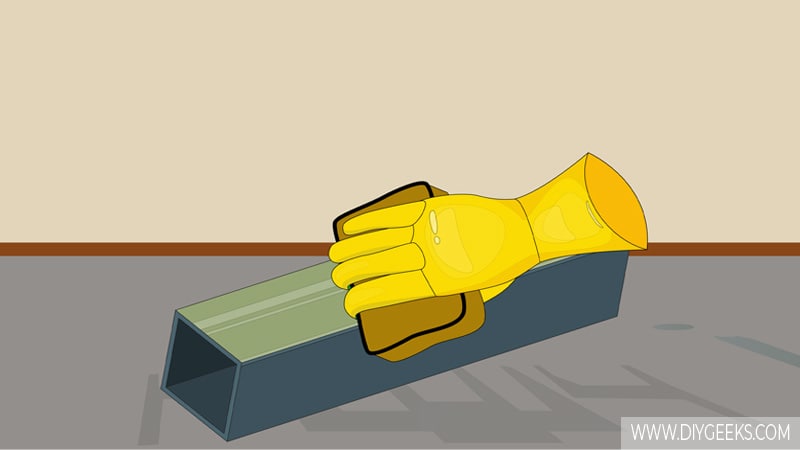
Sanding is the easiest way to remove spray paint — rub the sandpaper against the surface and the finish will wear off.
Start sanding with medium-grit sandpaper (100-grit) and finish with fine-grit sandpaper (240-grit). Medium-grit sandpaper will strip the finish off, and the fine-grit sandpaper will smoothen the surface.
Here is a guide for this method:
- Wipe the surface to remove loose dirt and debris.
- Start sanding with medium-grit sandpaper and finish with fine-grit sandpaper.
- Remove the dust using a vacuum and inspect the surface for leftovers
- If there are leftovers, sand again and clean the surface.
2. Scrape it Off
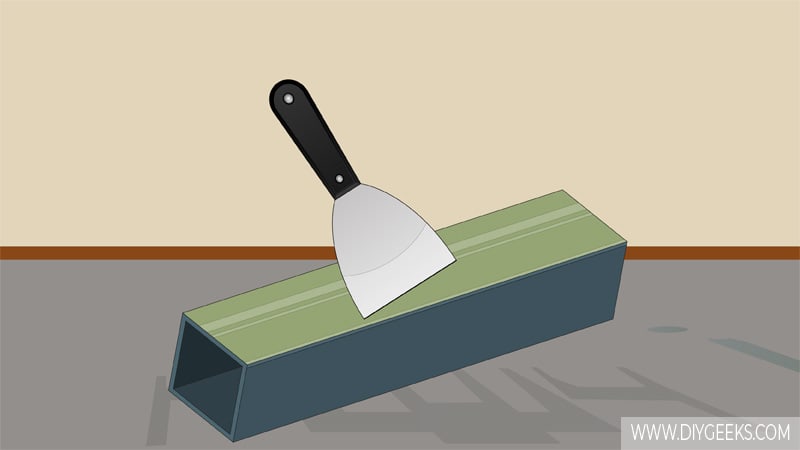
Scraping works best on old and chipping finishes because they aren’t strong enough. For normal finishes, soft them first and then scrape them off.
Here is a guide for this method:
- Use warm water and soap to soften the finish.
- Use a plastic scraper or wire brush to scrape the finish. Don’t use metal scrapers as they can scratch the metal.
- Wipe the surface with a clean rag to see if you have leftovers.
- For leftover paint, repeat the steps above.
Scraping the finish off will take time, especially on large surfaces. So only use this method for small surfaces.
3. Use a Hairdryer
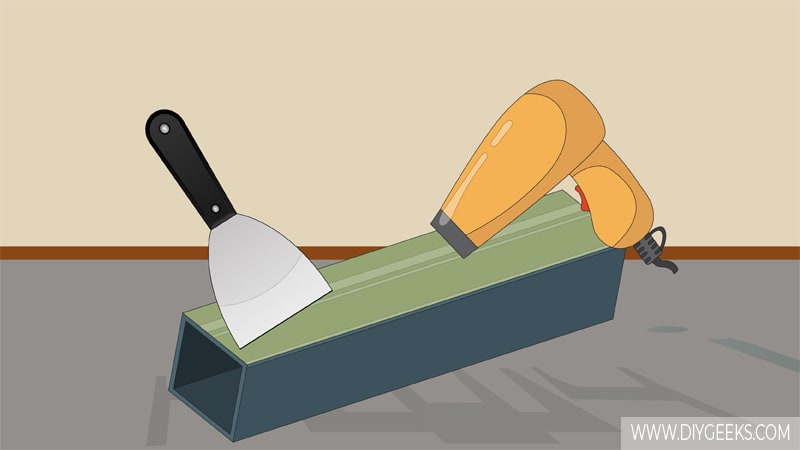
You can soften the finish with a hairdryer and then use a scraper to remove it. Spray paint is not heat-resistant and will blister off if exposed to sufficient heat from your hair dryer or heater.
Here is a guide for this method:
- Plug in and turn on your hairdryer.
- Move the hairdryer around the coating (keep a distance of about 4 inches between the hairdryer and the surface).
- Wait till the coating starts to bubble and tear off the surface (put on a pair of leather gloves).
- Turn off the hairdryer and use a scraper to scrape the loose coating off.
- Repeat the steps above if you have any leftovers.
- Wipe the surface with a rag when it cools down.
How To Remove Spray Paint From Metal Using Solvents?
To remove Spray paint from metal using solvents, do the following things.
1. Use Rubbing Alcohol or Acetone
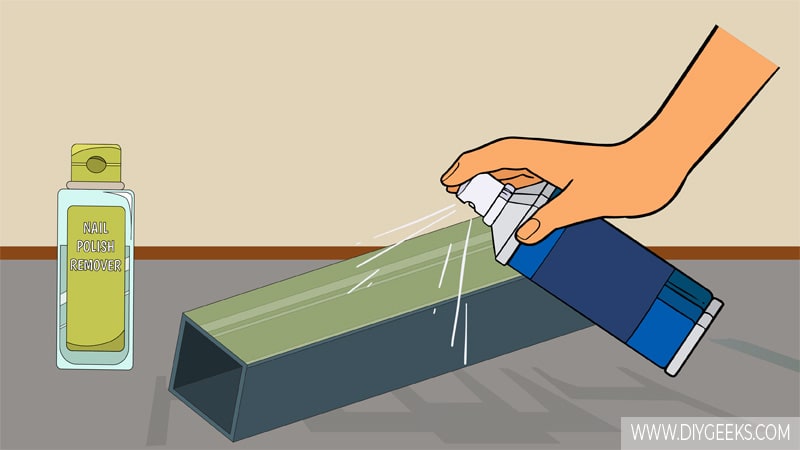
Alcohol is a natural paint remover, and acetone or rubbing alcohol has large amounts of it. The alcohol will penetrate and dissolve the finish by causing the particles to lose their bond. Once the particles lose their bond, the coating will swell up and you scrape it.
Here is a guide for this method:
- Pour rubbing alcohol or acetone into a clean bucket (you can mix both chemicals if you want).
- Dip a clean rag into the mixture.
- Let the rag soak and then squeeze it to remove the excess product.
- Use the damp rag to wipe the finish repeatedly.
- Let the alcohol over the finish until the coating starts to swell or bubble.
- Use a microfiber cloth or soft sponge to scrub the loose paint off.
- Wipe and clean the surface.
You can also use a plastic scraper to scrape the coating that is swollen.
2. Use Baking Soda
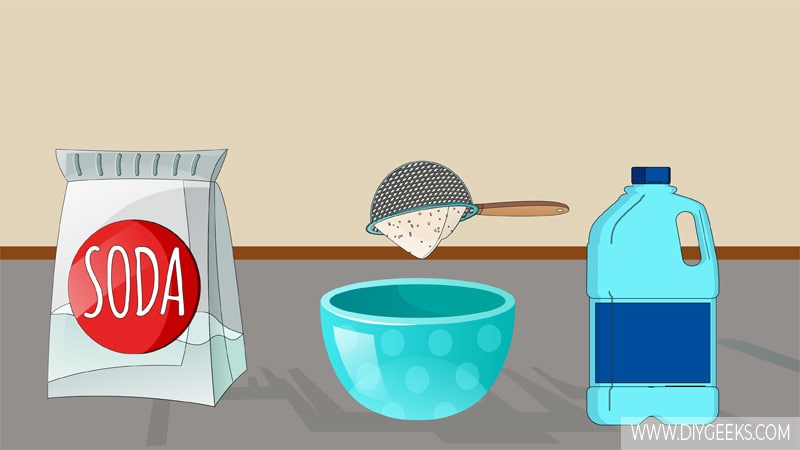
Baking soda has a natural alkaline compound that is safe to use on metal. When mixed with warm water, baking soda becomes an aggressive cleaner that will peel the spray paint off.
Here is a guide for this method:
- Get a clean pot.
- Pour some baking soda into the pot and mix it with water.
- Then put the metal object inside the mixture pot.
- Put the pot on the stove and use the lowest setting.
- Wait between 20 and 30 minutes for the baking soda to simmer.
- Turn off the stove and remove the metal from the pot.
- Using a scraper, scrape the loose coating off of the metal surface.
- Wipe the metal with a clean rag and leave it to dry.
The downside to this method is that it only works for small surfaces that can fit in a pot
3. Use a Chemical-Based Paint Stripper
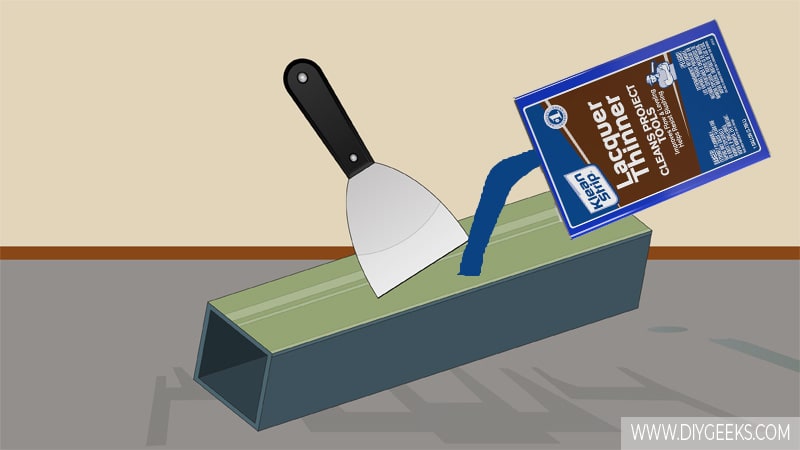
The paint stripper contains ingredients that will penetrate the finish and break the adhesion between the coating and the surface. This causes the coating to swell and makes it easier to wipe it off.
Here is a guide for this method:
- Wipe and clean the surface with a rag.
- Apply the stripping compound to the surface using a paintbrush or putty knife.
- Wait for a few minutes.
- When you notice the coating swelling, use a plastic scraper to scrape off the finish.
- Repeat the steps above if there are any leftovers.
- Clean the surface with mineral spirits.
- Leave the surface to dry.
4. Turpentine
Turpentine is a petroleum-based solvent used for clean-up and stain removal. You can use turpentine to strip fresh coatings from a surface, but it won’t strip dried (or cured) finishes.
5. Paint Remover
Paint removers are designed with active ingredients like methylene chloride and can be used to strip spray paint. Some removers are alcohol-based, and you can safely use them on metal.
However, some removers can’t be used. So, always check the manufacturer’s instructions to know.
6. Power Washing
Using pressure washers to strip a sprayed finish from metal works. But, only if you are removing old finishes that have started to peel off or chip. If the finish is new, power washing won’t strip it. Instead, it will make it weak so the stripping compound can remove it more easily.
7. Paint Thinner
A paint thinner can be used to strip spray paint, but only a certain type of thinner can be used on metal. If the thinner isn’t recommended for metal, don’t use it.
Thinners contain several chemicals including naphtha, toluene, and xylene that can discolor a surface.
Products You Shouldn’t Use:
Vinegar
Vinegar is a mild acid capable of corroding and damaging the metal surface. Also, it can cause discoloration on the surface and make it unpaintable.
Though a mild acid, vinegar is still an acid and as such, its chemical composition poses a threat of corrosion to the metal frame. However, vinegar is sometimes diluted in warm water and also mixed with baking soda (an alkaline compound) to reduce its potency on metal.
White Spirits
You shouldn’t use white spirits as it isn’t strong enough to strip a sprayed finish. The solvent may remove some water-based finishes, but that isn’t guaranteed.
WD-40
WD-40 is a cleaning product and won’t strip sprayed finishes from a surface. The cleaner is paint-friendly and will remove dirt and debris over a coating, but not the coating.
Bleach
You should never use bleach as it will corrode and eat away at the metal frame. Using bleach to remove paint will discolor the surface and make it weak.
How Long After Removing Spray Paint Can You Repaint Metal?
You must wait around 4 hours until the metal is dry and neutralized before you can repaint it.
The removal method you used also determines how long to wait before repainting. For instance, if you remove the finish by sanding or scraping, you can repaint almost immediately because the surface doesn’t need to dry.
You must wait until the surface dries if you use a solvent to remove the finish. This takes a few hours depending on the size and type of metal.
You must always neutralize the metal after using chemicals as it removes the solvent residue that can damage the surface or prevent new paints from sticking. To neutralize the surface, use mineral spirits, white spirits, or turpentine.


